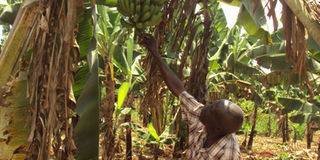Farmers resort to productive banana variety for better yields

Mr Godfrey Kizito, a commercial farmer in Kiwugu village in Kayunga shows off his bananas. Below, a fully grown bunch of Fhia 17 banana crop on Mr Kizito’s farm. Although farmers complain that the hybrid crop is not as tasty as indigenious types, they say that it is more productive and less demanding in terms of fertiliser application. Photo by FRED MUZAaLE
For many years, farmers in the central and western districts of Uganda have been growing indigenous banana varieties like Nakyetengu, Nakabululu, Kisansa, Ntika and others as a staple food crop and as a cash crop. But with the change in climatic conditions, decreasing soil fertility, increasing incidence of pests and diseases like the banana bacterial wilt and Black Sigotoka, banana productivity in the country has been in a continuous decline for a number of years.
Dr Andrew Kiggundu, a bio-technology scientist with Kawanda National Agricultural Research Organisation centre, explains that after yields of indigenous banana varieties declined, many farmers in the central parts of the country and in western districts of Masindi, Kabarole, Bundibugyo and Hoima decided to try growing a hybrid banana variety called Fhia 17 whose official name is Kabana 3.Dr Kiggundu says while many farmers took on growing of the hybrid banana variety on either a commercial or subsistence scale and alongside the indigenous banana varieties, some opted to completely abandon growing of the indigenous varieties after discovering that the hybrid variety was more productive and less demanding in terms of fertiliser application.
He explains that apart from Fhia 17 banana variety being high yielding, the variety is resistant to main diseases like Black Sigotoka and banana bacterial wilt disease and is resistant to droughts.“Farmers who grow Fhia 17 are assured of high yields even when weather conditions are harsh.” Dr Kiggundu says. He adds that because of the variety’s ability to grow in areas with little rainfall, many farmers in mid-northern Uganda, in areas like Gulu, Oyam and Amuru and West Nile districts like Nebbi where growing of indigenous banana varieties was hard, also took up growing of the improved banana variety as a food and cash crop.
“Though not so good for eating as matooke, the banana variety has proved to be a major cash crop for many farmers in western and northern parts of Uganda where farmers export it to Southern Sudan,” he says. Dr Kiggundu, who describes the growing of Fhia 17 banana variety as “successful and ever on the increase” says in western Uganda, farmers mainly use the crop in the making of fruit juice and waragi while in mid northern Uganda, some farmers have it as matooke while others sell it to Southern Sudan where it is used for dessert.
Mr Godfrey Kizito, a prominent commercial farmer in Kiwugu village, Kangulumira sub-county, Kayunga district who has embraced growing of Fhia 17 alongside other indigenous banana varieties, says since he started growing the hybrid banana in 2005, he has registered a tremendous boost in the income he gets from selling his bananas.“The Fhia 17 bunches are big compared to the indigenous banana varieties so they fetch me a lot of money,” Mr Kizito says.
The farmer says that he sells his Fhia 17 bananas to traders from Kenya, Sudan and Tanzania. Mr Kizito also explains that he prefers Fhia 17 among all the Fhia hybrids because it is a multipurpose variety which can be roasted, fried, or eaten for dessert or as matooke. But Dr Kiggundu says that even though the hybrid banana has been successful mainly as a cash crop, many farmers don’t want to eat it as matooke because they say its taste is different from that of the indigenous varieties.“Some people in northern Uganda, West Nile region and Southern Sudan who don’t know the taste of the original matooke eat it because they don’t know the real taste of matooke but many use it to make juice and for dessert,” he says.
One of the farmers in Kyejonjo town council, Kyenjojo district, Mr James Karangwa says that Fhia 17 variety has helped him revive his juice making business which he says had collapsed 10 years ago after the Musa banana variety which he was using in making the juice almost got wiped out by the Banana Bacterial Wilt disease.“I use Fhia 17 banana to make juice and eat it as matooke,” Mr Karangwa says.
He, however, complains that the Fhia bananas are more difficult to peel and take a little longer to cook, but confesses that the yields are so good that his wife feels these differences are a small price to pay.
Mr Karangwa also says that the other challenge is the crop’s weak stem that can’t hold the big bunch. He is forced to put supportive poles on Fhia 17 stems that have bunches so that they don’t collapse and spoil the fruit.
The Kayunga district production officer Dr David Mugabi who confesses that many farmers in the district have embraced growing of Fhia 17 bananas on a commercial scale says that the only challenge with Fhia 17 is that few people in the area eat it as it is said not to be delicious. Dr Mugabi is however hopeful that the hybrid banana variety will solve the problem of food insecurity and poverty in many households in the district. Dr Kigundu says that apart from Fhia 17 hybrid which is widely preferred by farmers, a few farmers also grow other Fhia hybrids like Fhia 1, Fhia 2, Fhia 3, Fhia 21, and Fhia 23 on a small scale.




